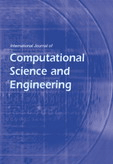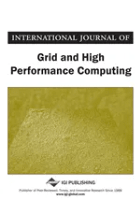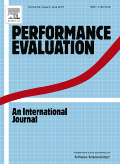
International Journal of Grid and Utility Computing
Scope & Guideline
Transforming Ideas into Practical Computing Solutions
Introduction
Aims and Scopes
- Grid and Utility Computing:
Research on the design, implementation, and optimization of grid and utility computing systems, focusing on resource management, load balancing, and performance enhancement. - Cloud Computing Innovations:
Exploration of new methodologies and technologies in cloud computing, including efficiency improvements, security measures, and privacy preservation. - Internet of Things (IoT) Applications:
Investigation of IoT technologies and their applications in various domains, such as smart cities, healthcare, and agriculture, emphasizing data management and analytics. - Machine Learning and AI Integration:
Application of machine learning and artificial intelligence techniques to improve system performance, predictive analytics, and decision-making processes. - Blockchain Technology:
Research on the application of blockchain technology for enhancing security, data integrity, and trust in distributed computing environments. - Edge and Fog Computing:
Studies focused on edge and fog computing architectures, including their integration with cloud systems and the implications for latency, scalability, and data processing.
Trending and Emerging
- Integration of AI and Machine Learning:
There is a notable increase in research focusing on the integration of artificial intelligence and machine learning techniques to enhance computational efficiency and predictive capabilities. - Blockchain Applications in Computing:
The use of blockchain technology for securing data transactions, enhancing privacy, and ensuring data integrity is becoming a significant area of exploration. - Edge and Fog Computing Solutions:
Research into edge and fog computing is on the rise, emphasizing their role in reducing latency and improving data processing for IoT applications. - Data Privacy and Security Mechanisms:
As concerns over data security grow, there is a heightened focus on developing innovative privacy-preserving techniques in cloud and utility computing. - Smart City and IoT Innovations:
Research related to smart city applications and the Internet of Things is increasingly prevalent, reflecting the growing importance of these technologies in urban planning and management. - Advanced Resource Management Techniques:
Emerging methodologies for dynamic resource management and optimization in cloud and grid computing environments are a trending focus, highlighting the need for efficiency in resource utilization.
Declining or Waning
- Traditional Grid Computing:
Research focused on traditional grid computing models has seen a decline, as newer paradigms such as cloud and edge computing gain prominence. - Basic Algorithm Designs:
Papers centered on basic algorithm designs without application to specific problems or technologies are becoming less frequent, as there is a shift towards more applied and interdisciplinary research. - Static Resource Allocation Methods:
Static methods for resource allocation in grid computing are waning as dynamic and adaptive techniques become more relevant in real-time data processing scenarios. - Low-Level System Architecture Studies:
Research that focuses solely on low-level architecture without considering broader system integration or application impacts is decreasing in favor of more holistic approaches. - Single-Domain Focus:
Studies that concentrate solely on one domain without interdisciplinary approaches are less common, as many researchers are now integrating multiple domains into their work.
Similar Journals

Journal of Grid Computing
Connecting Research and Industry in Grid ComputingThe Journal of Grid Computing, published by Springer, stands as a pivotal resource in the dynamic field of computer science, particularly within the realms of Computer Networks and Communications, Hardware and Architecture, Information Systems, and Software. With an impressive Q1 ranking across these categories in 2023, the journal exemplifies excellence and rigor, catering to a diverse readership from researchers to industry professionals. Established in 2003, this esteemed journal is anchored in the Netherlands and releases cutting-edge research that reflects trends and advancements in grid computing technologies. Researchers can gain insights through its vast contributions, while institutions benefit from its prestigious standing within the SCOPUS framework, boasting high percentile ranks in multiple computer science categories. Though not open access, the journal provides unparalleled access options for institutional subscribers, solidifying its importance as a gateway to innovative discoveries in high-performance distributed computing.

International Journal of Computational Science and Engineering
Exploring Innovative Solutions for a Digital FutureThe International Journal of Computational Science and Engineering, published by InderScience Enterprises Ltd, is a premier platform dedicated to the interdisciplinary field of computational science and engineering. With an ISSN of 1742-7185 and an E-ISSN of 1742-7193, the journal has been serving the academic community since its establishment in 2005 and will continue to do so until 2024. Notably categorized in the Q3 quartile for various domains, including Computational Mathematics, Software, and Hardware and Architecture, it holds respectable rankings in Scopus, evidencing its importance in advancing research and practice. While the journal is not open-access, it offers subscription options that ensure wide dissemination among researchers, professionals, and students. The journal aims to publish high-quality original research articles, survey papers, and case studies that contribute to the theoretical and practical aspects of computational techniques and methodologies. In a rapidly evolving digital landscape, this journal is a valuable resource for those seeking to push the boundaries of knowledge in computational science.

International Journal of Grid and High Performance Computing
Unlocking the Power of Grid and High-Performance ComputingThe International Journal of Grid and High Performance Computing, published by IGI Global, is a vital resource in the fields of grid and high-performance computing. With an ISSN of 1938-0259 and an E-ISSN of 1938-0267, this journal has been dedicated to advancing knowledge and innovation since its inception in 2009, and is set to continue publishing groundbreaking research until 2024. Despite its current Q4 categorization in the Computer Networks and Communications field, the journal plays a crucial role in fostering interdisciplinary collaboration and sharing pioneering work that addresses the growing demands of computational performance and network efficiency. Although it does not offer open access, subscribers gain invaluable insights into contemporary issues and developments within this rapidly evolving discipline. The journal aims to attract original research articles, reviews, and case studies, making it an essential platform for researchers, professionals, and students keen on exploring the complexities of grid computing and its applications.

International Journal of Networked and Distributed Computing
Empowering Scholars in the Realm of ComputingWelcome to the International Journal of Networked and Distributed Computing, published by SpringerNature, a premier outlet for cutting-edge research in the realms of computer networks and distributed computing systems. Established as an Open Access journal since 2013 and based in the Netherlands, this publication strives to disseminate high-quality, peer-reviewed studies that address the complexities of contemporary computing challenges. With an impact factor that reflects its growing influence—positioned in the Q3 category for both Computer Networks and Communications and Computer Science Applications—this journal serves as a pivotal resource for scholars and practitioners aiming to advance knowledge and innovation in this rapidly evolving field. The journal encompasses diverse topics, from network protocols to distributed algorithms, ensuring that researchers, professionals, and students can find relevant insights and methodologies to inform their work. Join us in exploring the depths of networked and distributed computing, contributing to a collaborative academic environment that shapes the future of technology.

Internet of Things
Exploring the Future of ConnectivityInternet of Things is a cutting-edge academic journal dedicated to the rapidly evolving field of interconnected devices and systems, published by Elsevier. Established in 2018, this journal has quickly ascended to prominence, achieving Q1 rankings across multiple disciplines including Artificial Intelligence, Computer Science Applications, and Engineering in its 2023 assessments. With its ISSN 2543-1536 and E-ISSN 2542-6605, it serves as a pivotal platform for researchers and professionals alike to disseminate innovative research findings, case studies, and reviews that address the complexities and opportunities within the IoT landscape. The journal’s impressive Scopus rankings further underline its significance, with notable placements in highly competitive categories. Although it operates under traditional publishing models, ensuring thorough peer review and academic rigor, Internet of Things remains at the forefront of technological discourse, facilitating knowledge exchange and collaboration among its audience. For those engaged in the dynamic fields of technology and innovation, this journal is an essential resource for up-to-date research and practical insights.

International Journal on Information Technologies and Security
Bridging Disciplines in Tech and SecurityInternational Journal on Information Technologies and Security, published by UNION SCIENTISTS BULGARIA, is a pivotal interdisciplinary journal that explores the rapidly evolving fields of information technology and security. With a robust ISSN of 1313-8251, this journal serves as a platform for researchers, professionals, and students to disseminate their findings and innovations in cybersecurity, data protection, and IT system integrity. The journal's commitment to open access enhances accessibility, ensuring that pivotal research reaches a broader audience, encouraging collaboration and advancement in these critical areas. As an invaluable resource for those engaged in the study and application of information security measures, the International Journal on Information Technologies and Security plays an essential role in shaping the discourse and driving forward the knowledge necessary to tackle today’s technological challenges.

COMPUTING
Shaping the Future of Numerical Analysis and ComputingCOMPUTING, published by Springer Wien, is a prestigious journal that has been at the forefront of computational research since its inception in 1966. With an ISSN of 0010-485X and an E-ISSN of 1436-5057, this journal is renowned for its rigorous peer-reviewed articles that span across various domains such as Computational Mathematics, Numerical Analysis, and Theoretical Computer Science. The journal consistently maintains a high impact factor, securing a Q1 ranking in multiple categories including Computational Mathematics and Computer Science Applications, thereby reflecting its influential role in shaping contemporary academic discourse. Although it does not currently offer open access options, the journal is widely accessible within academic institutions. Given its significant placement in Scopus rankings—most notably Rank #5 in Numerical Analysis—COMPUTING is an essential resource for researchers, professionals, and students who are engaged in advancing the field of computing. With its scope extending to innovative methodologies and theoretical advancements, COMFORTING continues to attract high-quality submissions, making it a cornerstone publication in the computational sciences.

Journal of Internet Services and Applications
Empowering scholars to shape the future of Internet applications.Journal of Internet Services and Applications is a leading scientific platform dedicated to the dynamic and evolving field of Internet technologies and applications, published by SOC BRASILEIRA COMPUTACAO. Since its establishment in 2010, the journal has transitioned to an Open Access model, ensuring that research is freely available to a global audience, fostering innovation and collaboration among scholars. With an impact factor solidifying its credibility in the academic community, the journal is ranked Q2 in Computer Networks and Communications and Q3 in Computer Science Applications as of 2023, demonstrating its relevance and contribution to these critical fields. The journal covers a wide array of topics including network design, application development, and the intersection of technology and society, making it a vital resource for researchers, professionals, and students alike. With a commitment to fostering cutting-edge research, the Journal of Internet Services and Applications remains a vital conduit for knowledge and advancement in the rapidly evolving domain of Internet services.

PERFORMANCE EVALUATION
Bridging Theory and Practice in Performance ResearchPERFORMANCE EVALUATION, published by ELSEVIER, is a prestigious journal that serves as a critical resource for researchers and professionals in the fields of Computer Networks and Communications, Hardware and Architecture, Modeling and Simulation, and Software. With its ISSN 0166-5316 and E-ISSN 1872-745X, this journal is recognized for its contribution to the advancement of performance assessment methodologies and empirical research. Holding a Q3 quartile ranking across multiple categories in 2023, PERFORMANCE EVALUATION is positioned as a valuable platform for disseminating high-quality studies that explore complex performance issues and innovative solutions. Operating from its base in the Netherlands, this journal emphasizes rigorous peer-review standards and enhances its relevance within the academic community by addressing crucial challenges and trends in technology. Stakeholders can access the wealth of knowledge published from 1981 through 2024 by exploring this journal, making it an essential tool for practitioners and scholars aiming to stay at the forefront of computer science research.

Future Generation Computer Systems-The International Journal of eScience
Transforming Ideas into eScience ExcellenceFuture Generation Computer Systems - The International Journal of eScience, published by ELSEVIER, stands at the forefront of the fields of computer networks, hardware architecture, and software engineering, as evidenced by its impressive Q1 quartile rankings in 2023 across these categories. With an ISSN of 0167-739X and an E-ISSN of 1872-7115, this esteemed journal has been a significant contributor to the body of knowledge in the computer science domain since its inception in 1984, continuing to shape the landscape of eScience through cutting-edge research and innovative practices. Featuring a broad scope that embraces various interrelated disciplines, Future Generation Computer Systems is particularly recognized for its high impact factor and prestigious Scopus rankings, where it ranks in the top echelons—8th in Computer Networks and Communications, 5th in Hardware and Architecture, and 17th in Software—placing it in the 95th to 98th percentiles of their respective fields. Although currently not open access, the journal provides invaluable insights and advancements aimed at researchers, professionals, and students alike, driving the evolution of technology and its applications in an increasingly digital world.